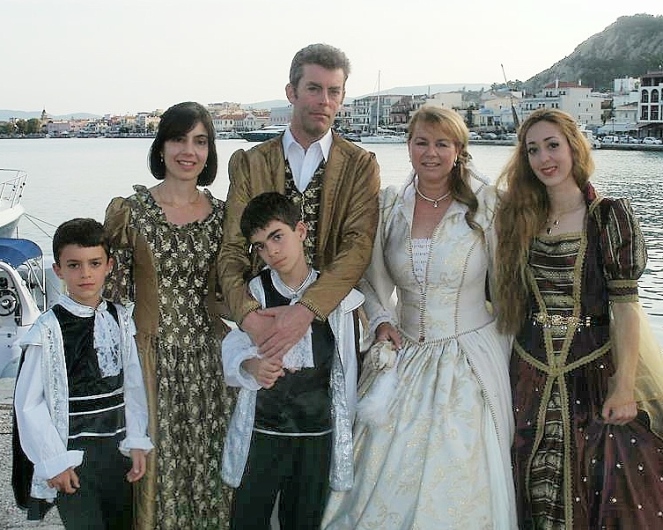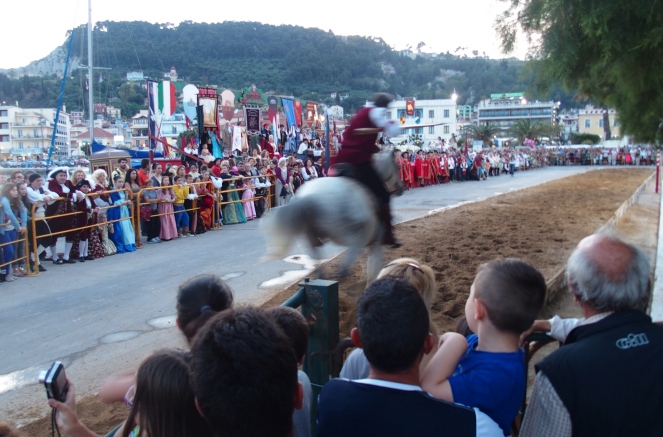One day on our previous visit to Zante two years ago we noticed workmen clearing up a large amount of sand on Solomós Square, the main square in Zákynthos town. We went about our business and thought no more about it. Reading the local paper the next day I found out what the sand had been for: jousting. I read that again: jousting? In Zákynthos? Ναι!
Turned out the jousting was a part of an event called Giostra Di Zante which is the modern-day revival of its medieval counterpart, first officially mentioned in the mid-17th century but probably much older than that. As well as involving knights on horseback competing in displays of skill, nowadays it also sees a parade of people, dressed as the Nobili of the time, march through the centre of the χώρα (Zákynthos town). The event dates from a time when the island was part of the Serenissima Repubblica di Venezia, which it was until 1797, a period lasting 312 years. The tradition was brought to life in 2005, and takes place over the three day weekend of ‘Holy Spirit’ day, despite originally being part of the Carnival.

Interesting local traditions like this were exactly what we wanted to experience this time in Zante; that’s why we’d decided to spend so much time here. And this would be a fun thing to have in our book about Zakynthos too. Normally we miss these events, if we’re even aware of them in the first place. However, unlike last time’s near miss, this year we realised we’d be around for Giostra, so we enquired about participating. Our friend Louise, an expat Aussie gone native with an encyclopaedic knowledge of Zákynthos and its customs (who we’d gone on a walk around Marathiá with recently), maintains the very popular Zakynthian tradition, food and culture facebook group and is on the Giostra Committee to boot, so she was definitely the woman to speak to. Yes, we could be in the team, but we’d need the right gear.
She togged out the kids with fetching black and white costumes quick enough but Tina and I would have to get ours made if we wanted to walk in the parade too. We did, so we did. Louise put us in touch with a seamstress and costume designer called Maria. Over a couple of mornings we were measured and fitted for nobility threads in Maria’s atelier near the church of Ágios Análipsi. It was expensive, given the one-off nature of the costumes, but we see them as a commitment device, something that means we are more likely to come back here more often.

Tina and the kids had done the Saturday parade, and they’d seen the kids’ jousting event, but lacking our own car, Sunday, the final day, was the only time we could make it en famille. With long-johns, three-quarter length pantaloons, a white shirt, a frilly lace waistcoat, and an outer jacket to march in, I was hoping for a mild one, weatherwise, on the day. Tina was in a full-length taffeta dress, so she felt the same. In the event we were fine, just about. I can see why they don’t do this in July or August though.
We parked somewhere behind the unfinished symphony of the Theatre, and walked though the back streets up to the gathering point, the square of Ágia Sarandon. Where? Oh, the junction with the períptero where Alexándrou Róma turns into Tavoulári. Never knew it was called that. Walking up there I felt like an extra in a Prince video, but once we reached the spot I soon realised that, if anything, I was underdressed.
There was a team mainly composed of women in blue peasant dress with white headdresses and smocks, from Argostoli, in Kefalonia; a team with a banner saying “Parartima Kerkyras”, from Corfu; a troupe of kids from “Sikolithia Ampelokipon” – must be from Ambelókopoi – something to do with Louise’s team? I saw a fearsome consort of a dozen or so more Italians with swords, daggers, and pikes. Ladies with white wigs; men with white wigs and jackets, whose salty wind-lined faces scarcely needed them to be wearing period costume to be worth a photograph. Banners with “Rióro tou Levante, 1964, Zákynthos”, and from further afield, “Giostra Cavallerescra di Sulmona”: people from the island here regularly travel to the Italian town of Sulmona to participate in the even more spectacular Giostra there.
Louise arrived almost late, and feeling hassled (she’d been delayed at home on this most important of days). Right behind us an Italian drumming team with blue and yellow harlequin outfits struck up a tattoo which was the signal to start. We set off on a road I’m well familiar with, but had never walked down feeling quite so distinguished. It was the most local, the most ‘on the inside’ of events I’d ever felt in all the years I’ve been coming here. Lining the route I saw some familiar faces; the kids’ headmaster, the librarian, cheering and clapping, and, laying in ambush with her camera at the square of Ágios Análipsi, good ol’ Mum.
Somewhere far behind us a quartet of pageboys shuffled along, holding a velvet canopy below which the Maestro di Campo strode, bewigged, berobed, and bestaffed; a white horse and carriage with what I took to be the patron lady clip-clopped obediently behind. And somewhere in the tail of all this parading was the town crier, the general secretary, the judges, the maidens (on whose behalf the knights will compete), and finally, the jousters themselves, the knights on horseback.

Where Alexándrou Róma turns into the street whose name is 21 Máiou, we turned off the main route down towards the water. This was of course because the squalid condition of the usual arena for these events, Solomós Square, meant that you wouldn’t bring your dog there, let alone horses, teams of drummers, and ladies with long-trained dresses. It was only then, as I walked past it, did it occur to me that even if they couldn’t change the fact that the square was banjaxed and probably wouldn’t be ready this season, they could have at least improved its appearance by removing the graffiti on the horse-high metal barriers that surround the works, which at the moment gives the place the appearance of belonging to a shanty town. In Australia, when graffiti occasionally makes it to the bike lane I commute to work through, it’s usually removed within a day or two. Not that many people would have seen it, but there’s zero tolerance for vandalism like that. I can take a little graffiti in the right place, but my God, this insult to the town’s injury here on the square should be scrubbed off or painted over posthaste. Why the authorities, business owners, or tourism bigwigs can’t see that this is a disgrace that could easily be fixed is beyond me: even the courthouse, on Tertséti, is a mess, appropriately enough.
So as we passed the lost cause of the main square, I felt proud to be part of a team, and a town, that was keeping calm and carrying on. People were having fun, honouring tradition, and dressing themselves and their kids up, in the face of incompetence, or worse. What’s even more impressive is that similar-minded people from San Marino, Croatia, and Italy, not to mention the other islands of the Heptanese, were happy to join in. We marched across the Strada Marina to take up position by the stage at the Square of ‘Pesonton’, the small space on the edge of the harbour at the foot of Ágios Nikoláos Quay, where yachts and the round-the-island boats are parked.
Over the next half an hour the remaining paraders spooled into the enclosure where those of us who had already finished waited, as the crowd of onlookers opposite us thickened. In short order, the fearsome Italian pikemen I mentioned earlier did a mock swordfight, which then degenerated to a dagger fight, and then a brawl, all over a maid’s honour, it seemed; the team from San Marino did some fancy flag-tossing; and the town crier warmed us up for the actual jousting. Finally, the sand! Was it the same sand we’d seen two years ago on the square? In my mind it was.
As the light began to go, six different horsemen, each representing an arbitrarily-chosen destination, like Corfu, San Marino, or indeed Zákynthos, took turns using a lance (on a charging horse, mind) to try and capture a ring hanging from a pole. Tina and I picked our man: Andreas, who we’d met at the Laganás Horse Riding Centre the previous week. The riders all made it look so straightforward on the night of the Giostra, but we’d watched him struggle for half an hour at Laganás to get his white steed into a horse box to go off and practice jousting, so we had an idea of the work that goes on behind the scenes.

Alas, despite a strong showing from Andreas (three out of three in the first round), he didn’t end up the victor this year. Improbable as it seemed, that honour went to a young guy whose first ever Giostra this was. He took his prize of a sword, whisked his maiden up on the horse, and rode a valedictory lap.
It was time for us to make like the daylight, and go. The Giostra Di Zante had given me a fun, authentic glimpse into Zante’s Venetian heritage, and I’d enjoyed being part of the team. I’ll go further: I was honoured to have been allowed to participate, and our thanks go to Louise for letting us do that. Next year’s Giostra starts on 19th June, 2016: now we all have the gear, we’d be crazy to miss it.

I lived in Zakynthos for two years, i had a small farm and tried the “Good Life” unfortunately a serious injury forced me to return to the UK, but the wonderful, funny and out and out unbelievable stories and events i was part of will stay with me forever. the Zakynthian people are like their culture so different and refreshing.
LikeLike
Sounds like a fabulous experience Ralph. I guess severe debt manifests itself in a lack of graffiti cleaners when you need them.
Having all the gear now, I expect a spirited rendition of Purple Rain when you get back.
LikeLike